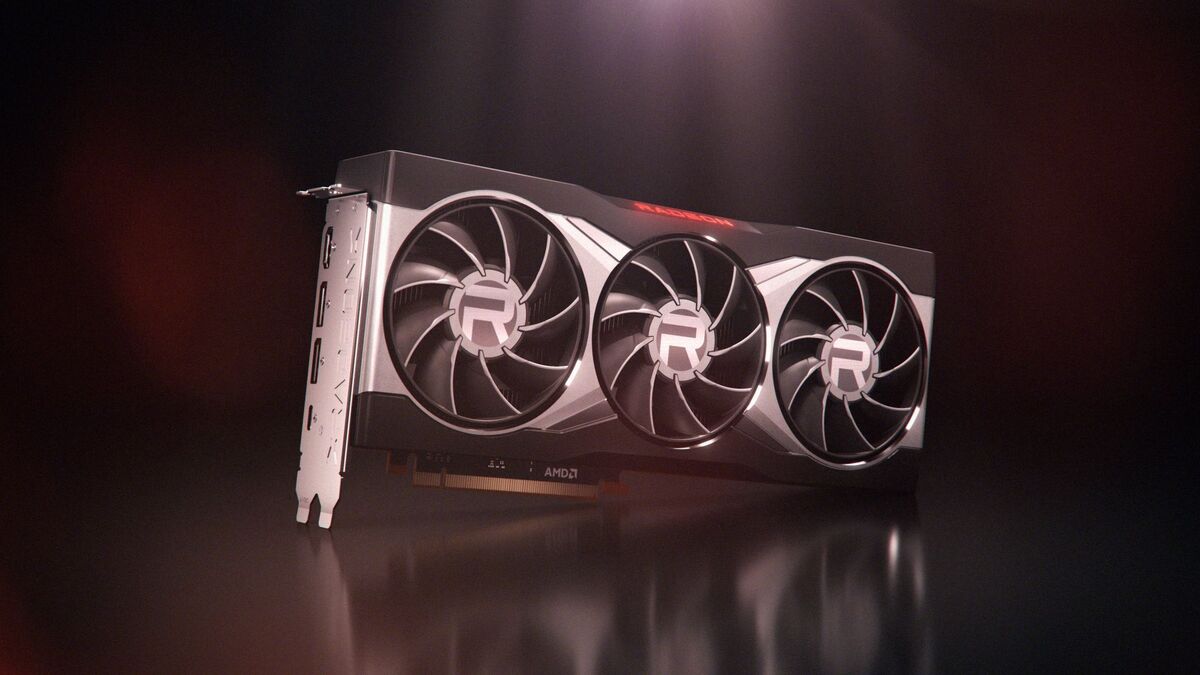Buttery smooth, ultra-fast ultrawide gaming
AMD
Today’s Best Tech Deals
Picked by PCWorld’s Editors
Top Deals On Great Products
Picked by Techconnect’s Editors
The Radeon RX 6900 XT is finally here and it is magnificent, as you’d expect from a graphics card that costs a staggering four figures. At $1,000, AMD’s first enthusiast-class gaming flagship doesn’t come cheap—but it’s a lot cheaper than its primary competition, the $1,500 GeForce RTX 3090. The Radeon RX 6900 XT wins some and loses some depending on the game, but overall, it’s 9 percent slower than the GeForce RTX 3090 at 4K resolution across our testing suite, while a mere 2 percent slower at 1440p.
How does it hang at 3440×1440 ultrawide gaming, which essentially splits the difference between 4K and 1440p? Very, very well. Let’s dig in.
Other Radeon RX 6000-series information:
- AMD Radeon RX 6900 XT review: Blisteringly fast, but very niche
- Tested: 5 key things you need to know about AMD’s Radeon RX 6900 XT
- RDNA 2 deep-dive: What’s inside AMD’s Radeon RX 6000 graphics cards
- AMD Radeon RX 6800 and RX 6800 XT review: A glorious return to high end gaming
Radeon RX 6900 XT 3440×1440 ultrawide benchmarks
We conducted our tests on the $550, 144Hz Nixeus EDG34S monitor we’ve used for prior ultrawide testing. It’s an outstanding value for the price, if a bit short on features, and the display supports AMD’s FreeSync Premium adaptive sync technology. You’ll need to use the monitor’s on-screen display to activate adaptive sync first, however.
Here’s a list of what’s inside our GPU test system, which was built to minimize potential bottlenecking in other components, putting the full brunt of the tests on the graphics card itself:
- Intel Core i7-8700K processor
- EVGA CLC 240 closed-loop liquid cooler ($105 on Amazon)
- Asus Maximus X Hero motherboard
- 64GB HyperX Predator RGB DDR4/2933 ($355 on Amazon)
- EVGA 1200W SuperNova P2 power supply ($352 on Amazon)
- Corsair Crystal 570X RGB case, with front and top panels removed and an extra rear fan installed for improved airflow
- 2x 500GB Samsung 860 EVO SSDs ($57 each on Amazon)
Each game is tested using its in-game benchmark at the highest possible graphics presets unless otherwise noted, with VSync, frame rate caps, real-time ray tracing or DLSS effects, and FreeSync/G-Sync disabled, along with any other vendor-specific technologies like FidelityFX or Hairworks. We’ve also enabled temporal anti-aliasing (TAA) when it’s available. Check out our full Radeon RX 6900 XT review for deeper insight into our methodology.
We’ll present the raw benchmark results after introducing each game. Skip to the end for deeper performance analysis.
Watch Dogs: Legion
Watch Dogs: Legion is one of the first games to debut on next-gen consoles. Ubisoft upgraded its Disrupt engine to include cutting-edge features like real-time ray tracing and Nvidia’s DLSS. We disable those effects for this testing, but Legion remains a strenuous game even on high-end hardware with its optional high-resolution texture pack installed. No card can maintain a 60 frames-per-second average with Ultra graphics options enabled, and the game allocates more than 8GB of memory even at 1440p. Oof.
 Brad Chacos/IDG
Brad Chacos/IDGHorizon Zero Dawn
Yep, Sony exclusives are hitting the PC now. Horizon Zero Dawn hit Steam with some performance issues, but the most egregious ones have mostly been cleared up thanks to hard work from the developers, and the game topped the sales charts for weeks after its release. It also seems to respond somewhat to PCIe 4.0 scaling, which will make this an interesting inclusion when we shift to a PCIe 4.0-based system in the future.
Horizon Zero Dawn runs on Guerrilla Games’ Decima engine, the same engine that powers Death Stranding. Ambient Occlusion can still offer iffy results if set to Ultra, so we test with that setting at Medium. Every other visual option is maxed out.
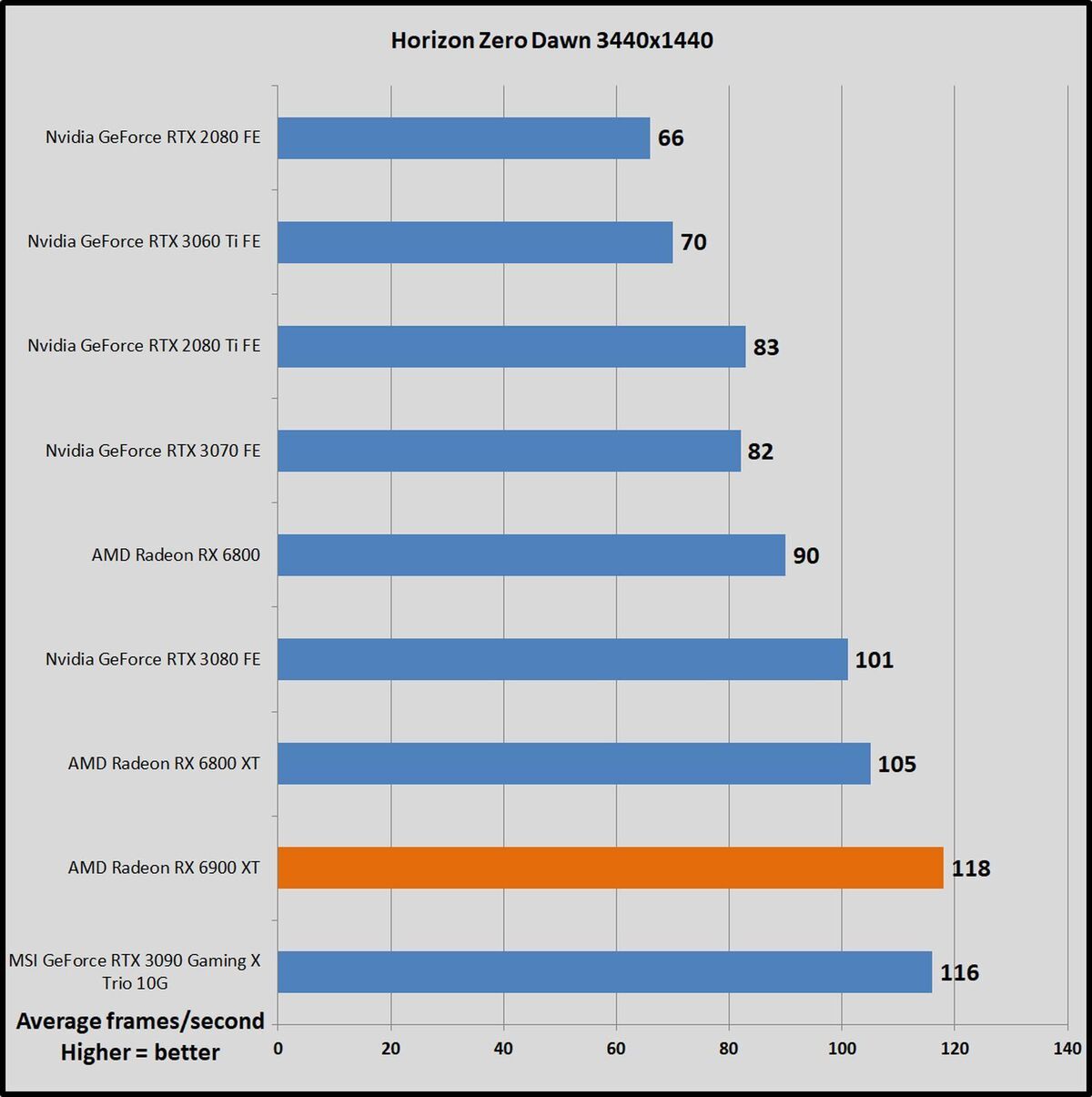 Brad Chacos/IDG
Brad Chacos/IDGGears Tactics
Gears Tactics puts it own brutal, fast-paced spin on the XCOM-like genre. This Unreal Engine 4-powered game was built from the ground up for DirectX 12, and we love being able to work a tactics-style game into our benchmarking suite. Better yet, the game comes with a plethora of graphics options for PC snobs. More games should devote such loving care to explaining what flipping all these visual knobs mean.
You can’t use the presets to benchmark Gears Tactics because it intelligently scales to work best on your installed hardware, meaning that “Ultra” on one graphics card can load different settings than “Ultra” on a weaker card. We manually set all options to their highest possible settings.
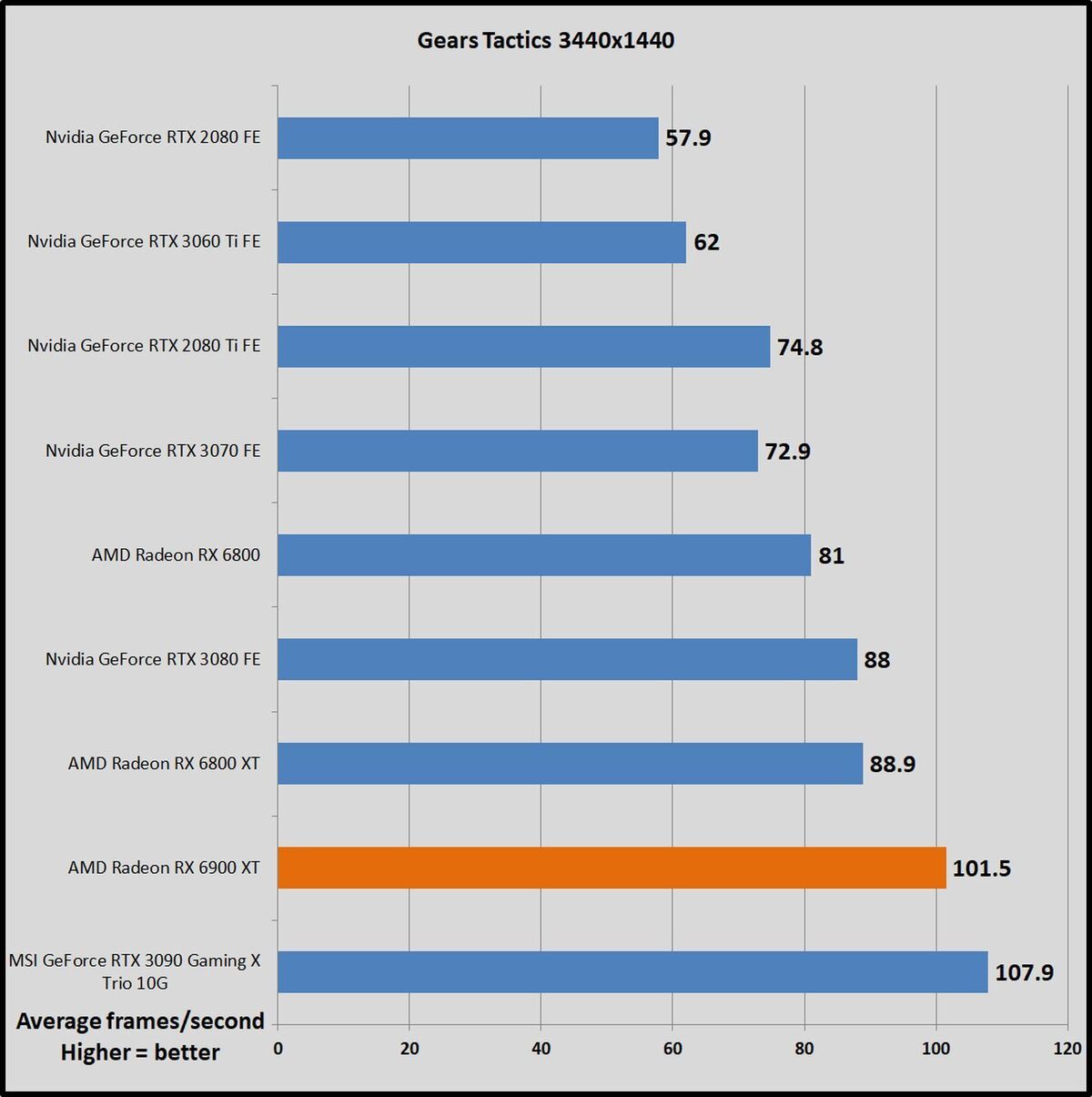 Brad Chacos/IDG
Brad Chacos/IDGMetro Exodus
One of the best games of 2019, Metro Exodus is one of the best-looking games around, too. The latest version of the 4A Engine provides incredibly luscious, ultra-detailed visuals, with one of the most stunning real-time ray tracing implementations released yet. We test in DirectX 12 mode with ray tracing, Hairworks, and DLSS disabled for our basic benchmarks.
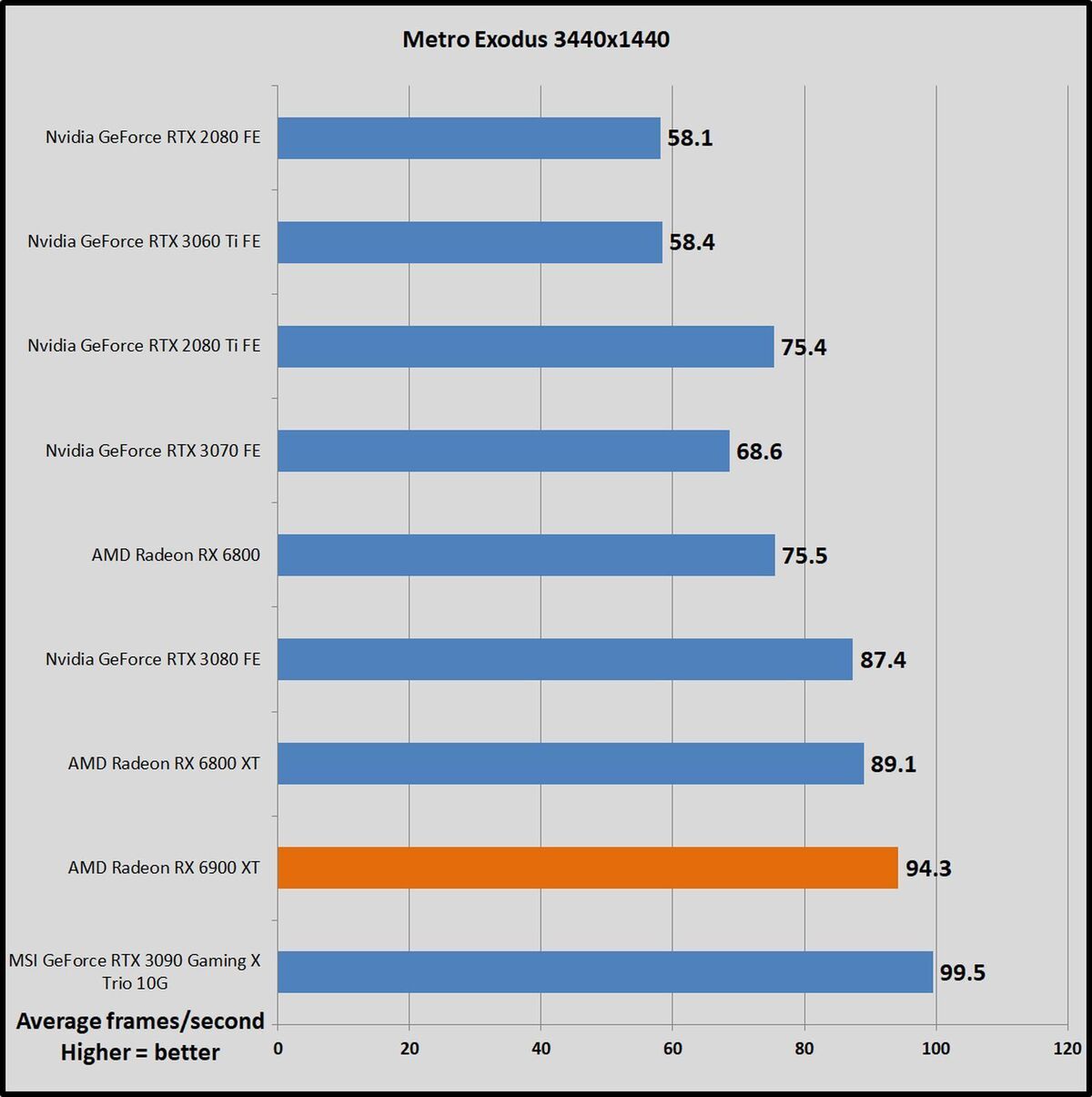 Brad Chacos/IDG
Brad Chacos/IDGWolfenstein: Youngblood
Wolfenstein: Youngblood is more fun when you can play cooperatively with a buddy, but it’s a fearless experiment—and an absolute technical showcase. Running on the Vulkan API, Youngblood achieves blistering frame rates, and it supports all sorts of cutting-edge technologies like ray tracing, DLSS 2.0, HDR, GPU culling, asynchronous computing, and Nvidia’s Content Adaptive Shading. The game includes a built-in benchmark with two different scenes; we tested Lab X.
 Brad Chacos/IDG
Brad Chacos/IDGStrange Brigade
Strange Brigade is a cooperative third-person shooter where a team of adventurers blasts through hordes of mythological enemies. It’s a technological showcase, built around the next-gen Vulkan and DirectX 12 APIs and infused with features like HDR support and the ability to toggle asynchronous compute on and off. It uses Rebellion’s custom Azure engine. We test using the Vulkan renderer, which is faster than DX12.
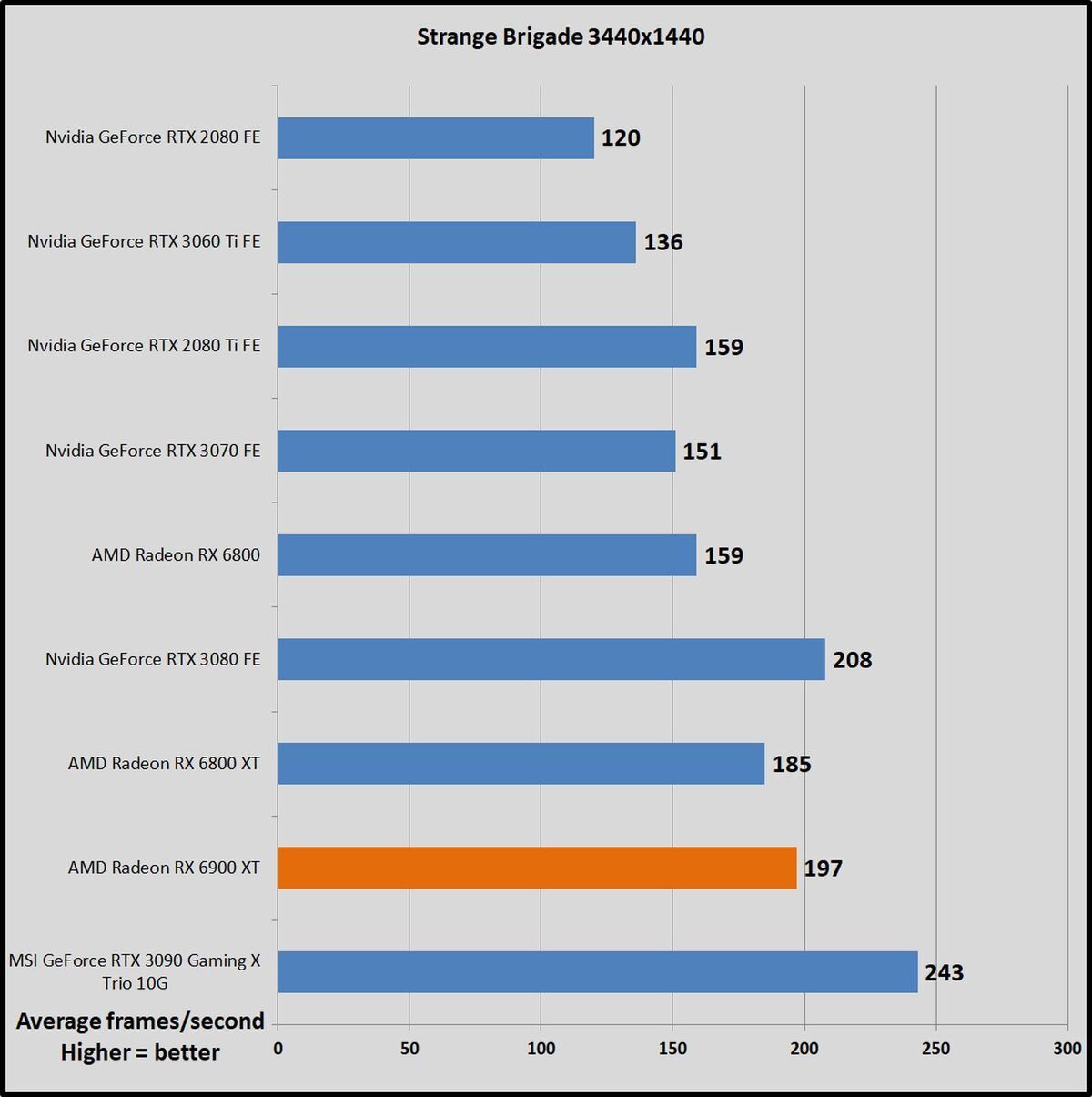 Brad Chacos/IDG
Brad Chacos/IDGTotal War: Troy
The latest game in the popular Total War saga, Troy was given away free for its first 24 hours on the Epic Games Store, moving over 7.5 million copies before it went on proper sale. Total War: Troy is built using a modified version of the Total War: Warhammer 2 engine, and this DX11 title looks stunning for a turn-based strategy game.
 Brad Chacos/IDG
Brad Chacos/IDGShadow of the Tomb Raider
Shadow of the Tomb Raider concludes the reboot trilogy, and it’s utterly gorgeous. Square Enix optimized this game for DX12, and recommends DX11 only if you’re using older hardware or Windows 7, so we test with DX12. Shadow of the Tomb Raider uses an enhanced version of the Foundation engine that also powered Rise of the Tomb Raider and includes optional real-time ray tracing and DLSS features.
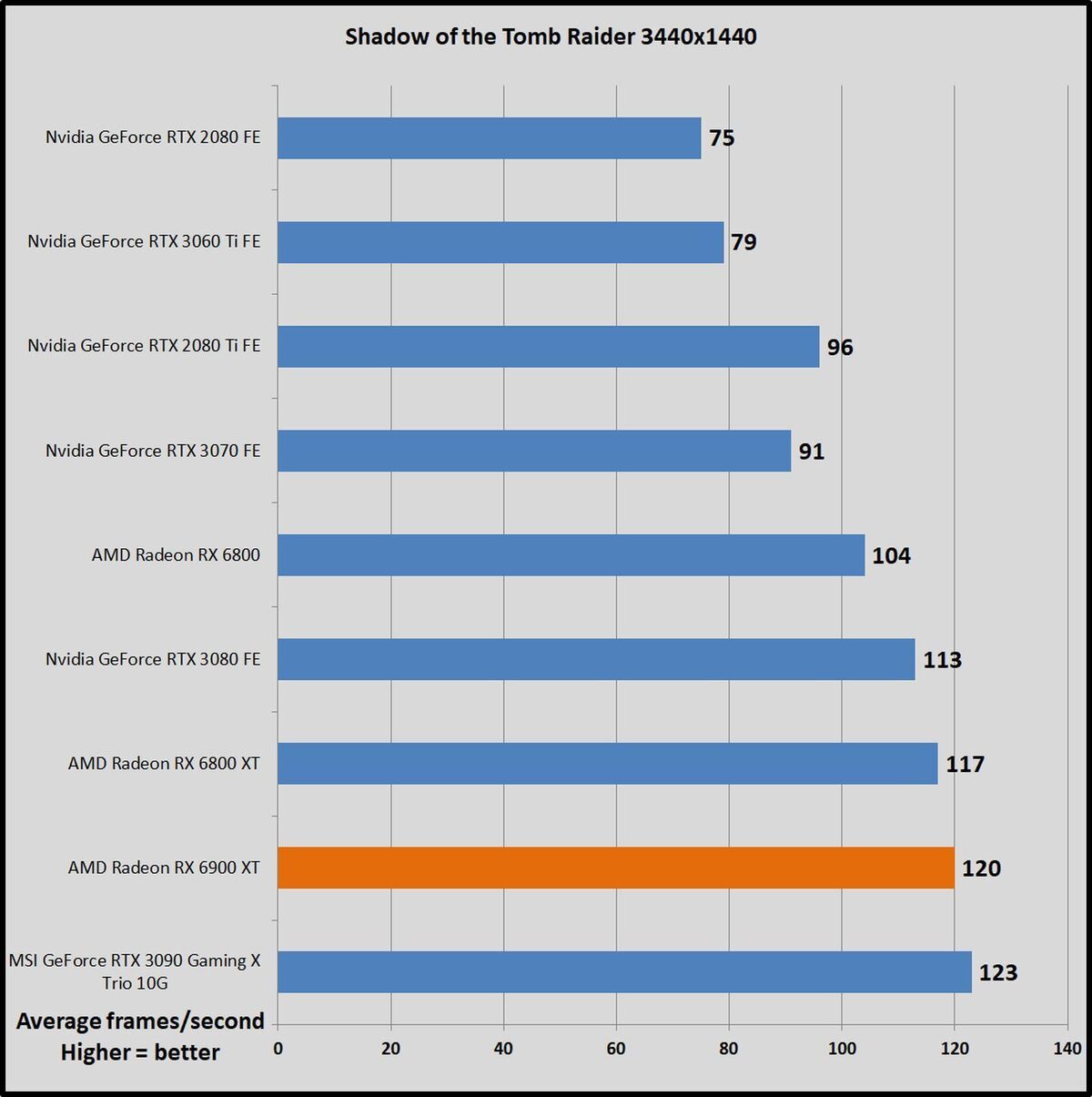 Brad Chacos/IDG
Brad Chacos/IDGRainbow Six Siege
Like GTA V, Ubisoft’s Rainbow Six Siege still dominates the Steam charts years after its launch, and it’ll be getting a visual upgrade for the next-gen consoles. The developers have poured a ton of work into the game’s AnvilNext engine over the years, eventually rolling out a Vulkan version of the game that we use to test. By default, the game lowers the render scaling to increase frame rates, but we set it to 100 percent to benchmark native rendering performance on graphics cards. Even still, frame rates soar.
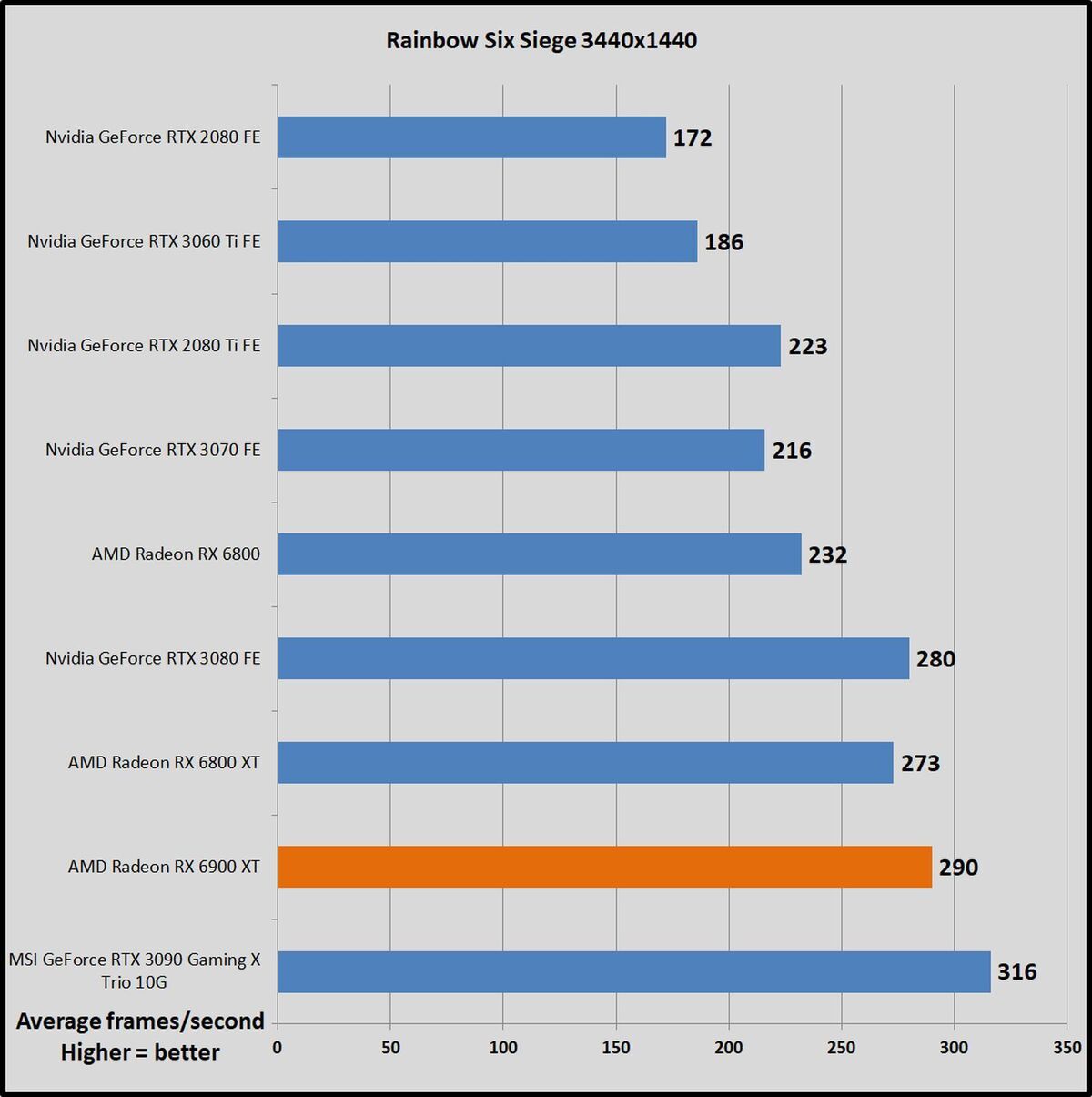 Brad Chacos/IDG
Brad Chacos/IDGFinal thoughts and analysis
Overall, the Radeon RX 6900 XT shines as a 3440×1440 ultrawide graphics card. It falls very close to the GeForce RTX 3090’s performance across our suite, aside from falling behind in Strange Brigade and Total War: Troy—two games that heavily prefer Nvidia’s architecture. The ample 16GB of memory will hold up against any game you throw at it in the foreseeable future. Considering it costs a whopping $500 less than the GeForce RTX 3090, the Radeon RX 6900 XT earns our nod as the ultrawide companion of choice in this flagship battle.
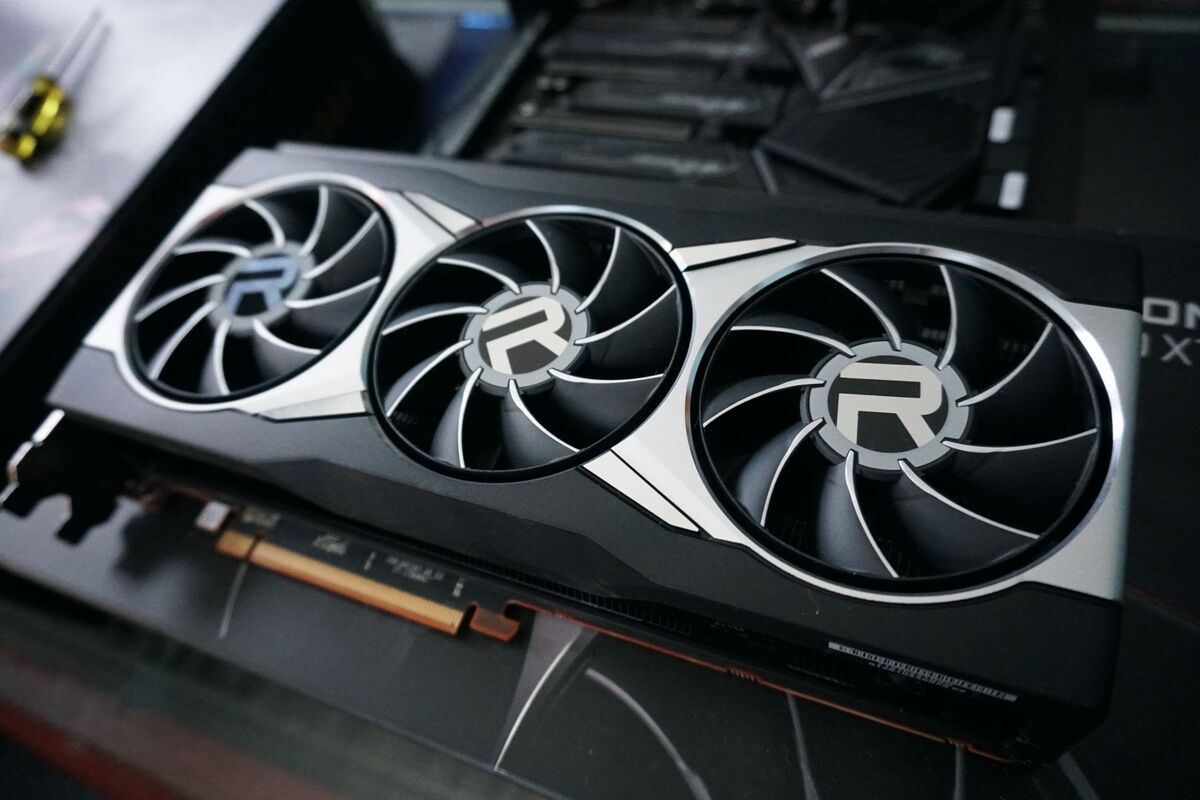 Brad Chacos/IDG
Brad Chacos/IDGThat doesn’t mean you should rush out to buy it, though. The Radeon RX 6800 XT and GeForce RTX 3080 perform nearly as well but cost hundreds of dollars less. Nvidia’s graphics card hold a significant performance advantage in ray traced games (which may or may not matter to you). If you want the best gaming performance period, price and value be damned, the GeForce RTX 3090 remains the fastest graphics card in the world overall.
If you want to delve deeper into the overall value proposition of AMD’s ferocious flagship GPU, be sure to check out our comprehensive Radeon RX 6900 XT review, or our briefer 5 key things you need to know about the Radeon RX 6900 XT if you don’t have time to sift through endless charts and analysis. If you’re curious about how AMD managed to pull off its surprising assault on Nvidia’s enthusiast-class graphics supremacy, our RDNA 2 architecture deep-dive explains all.
Note: When you purchase something after clicking links in our articles, we may earn a small commission. Read our affiliate link policy for more details.
Senior editor Brad Chacos covers gaming and graphics for PCWorld, and runs the morning news desk for PCWorld, Macworld, Greenbot, and TechHive. He tweets too.


